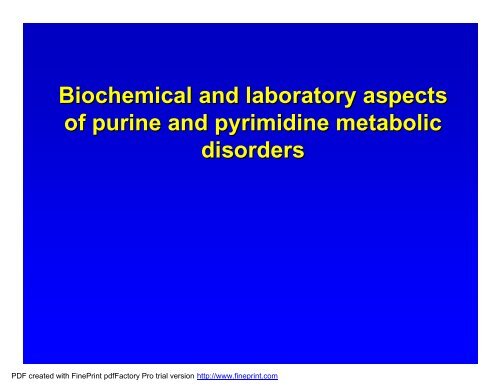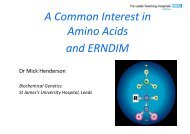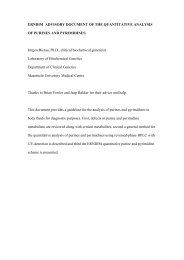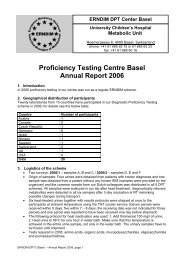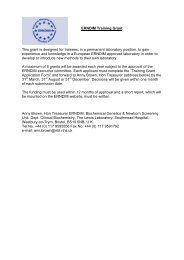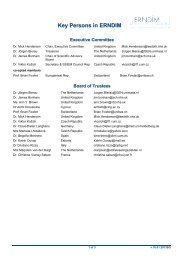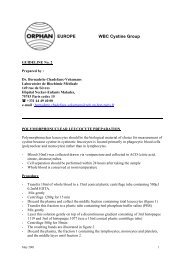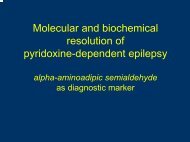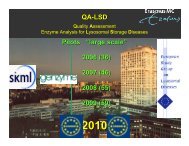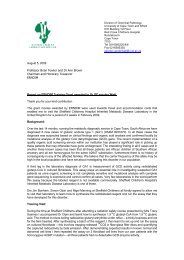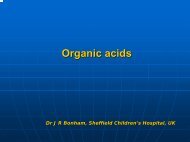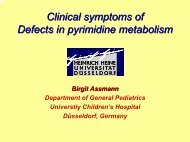Biochemical and laboratory aspects of purine and ... - ERNDIM
Biochemical and laboratory aspects of purine and ... - ERNDIM
Biochemical and laboratory aspects of purine and ... - ERNDIM
You also want an ePaper? Increase the reach of your titles
YUMPU automatically turns print PDFs into web optimized ePapers that Google loves.
<strong>Biochemical</strong> <strong>and</strong> <strong>laboratory</strong> <strong>aspects</strong><br />
<strong>of</strong> <strong>purine</strong> <strong>and</strong> pyrimidine metabolic<br />
disorders<br />
PDF created with FinePrint pdfFactory Pro trial version http://www.fineprint.com
Purine <strong>and</strong> pyrimidine disorders:<br />
<strong>Biochemical</strong> Aspects<br />
PDF created with FinePrint pdfFactory Pro trial version http://www.fineprint.com
Purine Metabolism:<br />
Characteristics<br />
• ‘de novo’ synthetic pathway makes<br />
nucleotides (energy requiring)<br />
•‘salvage’ mechanism recycles <strong>purine</strong> bases<br />
(energy saving)<br />
•uric acid is the end product in Man<br />
•strong dietary effect: food <strong>purine</strong>s urate.<br />
•Raised urate: Distinguish over-indulgence,<br />
over-production, <strong>and</strong> under-excretion.<br />
•Diagnosis: beware <strong>of</strong> drugs, dietary <strong>purine</strong>s.<br />
PDF created with FinePrint pdfFactory Pro trial version http://www.fineprint.com
BASES NUCLEOSIDES NUCLEOTIDES<br />
Pyrimidines…<br />
Pyrimidines<br />
O<br />
N<br />
NH2<br />
N<br />
Purines……<br />
Purines……<br />
N<br />
NH2<br />
N<br />
N<br />
NH2 NH2<br />
N<br />
N<br />
cytosine cytidine<br />
CMP<br />
(d)ribose phosphate (d)ribose<br />
N<br />
N<br />
NH2<br />
N<br />
N<br />
N<br />
N<br />
N<br />
N<br />
(d)ribose P~P~P (d)ribose<br />
adenine adenosine ATP<br />
PDF created with FinePrint pdfFactory Pro trial version http://www.fineprint.com<br />
N<br />
NH2<br />
N<br />
N
BASES<br />
Pyridines<br />
O<br />
C-NH2<br />
N<br />
nicotinamide<br />
O<br />
N<br />
Me<br />
O<br />
C-NH2<br />
Me2PY<br />
NUCLEOTIDES<br />
N<br />
O<br />
C-NH2<br />
PDF created with FinePrint pdfFactory Pro trial version http://www.fineprint.com<br />
[Pi]~ ribose- phosphate-phosphate-<br />
ribose<br />
N<br />
NH2<br />
N<br />
N<br />
N<br />
NAD[P]
PRPP<br />
Purine Synthesis<br />
DNA/ RNA/ Energy/ Cell Regulation<br />
de novo<br />
(10 steps)<br />
(d)ATP (d)GTP<br />
AMP GMP<br />
IMP<br />
PDF created with FinePrint pdfFactory Pro trial version http://www.fineprint.com
Purine Catabolism<br />
DNA/ RNA/ ATP/ GTP<br />
(d)AMP (d)GMP<br />
IMP<br />
(d)Inosine/(d)Guanosine<br />
Hypoxan/Guanine<br />
xanthine<br />
PDF created with FinePrint pdfFactory Pro trial version http://www.fineprint.com<br />
urate
Polyamines<br />
Purine Salvage<br />
DNA/ RNA/ Energy/ Regulation<br />
Adenine<br />
(d)ATP (d)GTP<br />
AMP GMP<br />
IMP<br />
Inosine/Guanosine<br />
Hypoxan/Guanine<br />
xanthine<br />
PDF created with FinePrint pdfFactory Pro trial version http://www.fineprint.com<br />
urate
Similar to <strong>purine</strong>s:<br />
Pyrimidine Metabolism:<br />
Characteristics<br />
• ‘de novo’ synthetic pathway<br />
•‘salvage’ mechanism recycles nucleosides<br />
•Catabolism leads into amino acid paths<br />
•dietary effect<br />
•Diagnostic problems include drugs.<br />
PDF created with FinePrint pdfFactory Pro trial version http://www.fineprint.com
Carbamyl<br />
phosphate<br />
DNA<br />
Pyrimidine Synthesis<br />
dTTP/dCTP<br />
de novo<br />
RNA, UDP/CDP-esters<br />
UTP CTP<br />
UMP<br />
PDF created with FinePrint pdfFactory Pro trial version http://www.fineprint.com
Pyrimidine Catabolism<br />
DNA<br />
RNA, UDP/CDP-esters<br />
UMP TMP CMP<br />
Nucleosides<br />
Bases (uracil, thymine)<br />
DPYD<br />
PDF created with FinePrint pdfFactory Pro trial version http://www.fineprint.com<br />
DPYS<br />
amino acids
DNA<br />
dTTP/dCTP<br />
Pyrimidine Salvage<br />
RNA, UDP/CDP-esters<br />
UTP CTP<br />
Nucleosides<br />
Bases<br />
PDF created with FinePrint pdfFactory Pro trial version http://www.fineprint.com<br />
UMP TMP CMP<br />
Dietary<br />
pyrimidines<br />
amino acids
Diagnosis –<br />
Purines<br />
PDF created with FinePrint pdfFactory Pro trial version http://www.fineprint.com
Uric acid: Gout / Stones / Hyperuricaemia:<br />
Ranges are critical!<br />
Urate fractional excretion on a creatinine basis (FEur)<br />
is both age <strong>and</strong> sex dependant.<br />
Diagnosis: Normal age+sex vs:<br />
-primary (age-onset) gout<br />
-familial juvenile hyperuricemic nephropathy<br />
(under-diagnosed!)<br />
-iatrogenic gout (drug induced,<br />
including vitamin C)<br />
-associated with other metabolic<br />
disease, e.g., MMA<br />
PDF created with FinePrint pdfFactory Pro trial version http://www.fineprint.com
Establishing a range –<br />
Usually based on 95% confidence limits<br />
but age brackets are arbitrary…<br />
<strong>and</strong> <strong>purine</strong> intake is diet/culture dependant.<br />
PDF created with FinePrint pdfFactory Pro trial version http://www.fineprint.com
Phosphoribosyl-pyrophosphate Synthetase<br />
(PRPS) superactivity<br />
Urine/plasma: hypoxanthine + urate overproduction.<br />
Red cells: nucleotide abnormalities = low GTP,<br />
low NAD.<br />
In vitro assay (red cells/fibroblasts):<br />
Difficult: known defects = allosteric regulatory<br />
mutations, or ?transcription up-regulation.<br />
Genotyping: Difficult: at least 2 loci on Xchromosome,<br />
no common mutations + maybe<br />
promoter mutations (Michael Becker, Chicago)<br />
under-diagnosed?<br />
PDF created with FinePrint pdfFactory Pro trial version http://www.fineprint.com
‘Lesch Nyhan Disease (LND)’:<br />
HPRT deficiency<br />
Urine/plasma: urate over-production (note<br />
importance <strong>of</strong> correct age-matched ranges!),<br />
raised hypoxanthine + xanthine.<br />
Red cells: nucleotide abnormalities = ‘ZTP’,<br />
high NAD & UDP-Glu; low GTP.<br />
In vitro assay (red cells/fibroblasts): ‘Easy’.<br />
Genotyping: Difficult: No common mutation,<br />
requires sequencing <strong>of</strong> the affected patient.<br />
‘Partial’ deficiency <strong>purine</strong> overproduction.<br />
In vitro assay: may mislead (needs intact assay)<br />
Underdiagnosed present late in renal failure<br />
PDF created with FinePrint pdfFactory Pro trial version http://www.fineprint.com
Adenosine deaminase (ADA) deficiency<br />
Urine <strong>and</strong> plasma: normal urate,<br />
adenosine+deoxyadenosine (lost on<br />
transfusion, which is common for ADA!)<br />
Red cells: abnormal nucleotide = deoxy-ATP<br />
(more residual following transfusion).<br />
In vitro assay (red cells/fibroblasts): ‘easy’<br />
but note transfusion problems.<br />
Genotype: difficult – no common mutations<br />
Late presenters: chronic viral infection<br />
underdiagnosed?<br />
PDF created with FinePrint pdfFactory Pro trial version http://www.fineprint.com
Purine nucleoside phosphorylase (PNP)<br />
deficiency<br />
Urine <strong>and</strong> plasma: low urate, (deoxy)guanosine<br />
+ (deoxy)inosine (but note transfusion urate!).<br />
Red cells: nucleotide abnormalities= deoxy-GTP<br />
+similar to LND: low GTP, high NAD & UDPG<br />
(resistant to transfusion changes).<br />
In vitro assay (red cells/fibroblasts): ‘easy’ but<br />
note transfusion problems.<br />
Genotype: difficult – no common mutations<br />
(very rare disorder).<br />
PDF created with FinePrint pdfFactory Pro trial version http://www.fineprint.com
Dihydroxyadeninuria:<br />
Adenine phosphoribosyltransferase (APRT)<br />
deficiency<br />
Stones: 2,8-dihydroxyadenine (not in <strong>ERNDIM</strong>)<br />
+ 8-hydroxyadenine.<br />
Urine <strong>and</strong> plasma:<br />
above + adenine.<br />
In vitro assay: ‘easy’.<br />
Genotype: some common mutations, incl type<br />
II (Japanese) mutation.<br />
?Underdiagnosed.<br />
PDF created with FinePrint pdfFactory Pro trial version http://www.fineprint.com
‘Xanthinuria’<br />
Xanthine oxidase deficiency:<br />
Stones: xanthine, no urate.<br />
Urine/plasma: raised xanthine, no/low urate; .<br />
Type 2 Xanthinuria (+Aldehyde oxidase defic):<br />
above + no Me2PY.<br />
MoCo deficiency (+Sulphite oxidase defic):<br />
Urine: above + sulphite, sulphocysteine.<br />
Plasma: homocysteine is v low/absent.<br />
In vitro assay: MoCo: specialist labs (Lyon).<br />
Genotyping: MoCo: at Guy’s (London);<br />
XOD gene: no common mutations (v rare!)<br />
PDF created with FinePrint pdfFactory Pro trial version http://www.fineprint.com
Adenylosuccinate lyase (ADSL)<br />
deficiency<br />
Urine <strong>and</strong> plasma: Succinyl-adenosine +SAICAR<br />
(neither in <strong>ERNDIM</strong> alternative = Bratton-<br />
Marshall test).<br />
In vitro assay: liver/muscle enzyme.<br />
Genotype: difficult – no common mutations<br />
(v. rare among N Europeans?)<br />
PDF created with FinePrint pdfFactory Pro trial version http://www.fineprint.com
Myelo-adenosine deaminase<br />
deficiency<br />
In vitro assay: muscle enzyme.<br />
Fore-arm exercise test: Measures ammonia<br />
<strong>and</strong>/or hypoxanthine(?accuracy).<br />
Genotyping: Deleterious polymorphism<br />
(10% Europeans), but alternate splicing<br />
unpredictable phenotype…<br />
Expression microarray study needed?<br />
PDF created with FinePrint pdfFactory Pro trial version http://www.fineprint.com
Diagnosis –<br />
Pyrimidines<br />
PDF created with FinePrint pdfFactory Pro trial version http://www.fineprint.com
Pyrimidine nucleotidase deficiency<br />
(Mild haemolytic anaemia +<br />
b-thalassemia interaction)<br />
Urine/plasma: no test.<br />
Red cells: raised pyrimidine nucleotides.<br />
Also: a commonly-used spectrophotometric<br />
assay (260/280nm ratio), sensitivity =?<br />
(especially if transfused)<br />
In vitro assay (red cells): ‘easy’.<br />
Genotype: difficult - no common mutations<br />
?under-diagnosed.<br />
PDF created with FinePrint pdfFactory Pro trial version http://www.fineprint.com
‘Thymine uraciluria’:<br />
Dihydropyrimidine dehydrogenase deficiency<br />
(DPYD)<br />
Urine <strong>and</strong> plasma: thymine + uracil (HPLC &<br />
GCMS).<br />
In vitro assay (white cells/fibroblasts): difficult!...<br />
but frequently requested for 5FU toxicity<br />
(‘pharmacogenetic’ test).<br />
Genotype: some common mutations but…<br />
a large gene, <strong>and</strong><br />
Unpredictable phenotype: ?secondary disorder,<br />
or protein-folding disorder (e.g., SCAD model).<br />
PDF created with FinePrint pdfFactory Pro trial version http://www.fineprint.com
‘Dihydropyrimidinuria’:<br />
Dihydropyrimidase deficiency (DPYS)<br />
Urine <strong>and</strong> plasma: dihydrothymine+dihydrouracil<br />
but difficult - no UV absorption, GCMS resistant.<br />
raised thymine, uracil (HPLC & GCMS).<br />
In vitro assay: liver enzyme.<br />
Genotype: no common mutations described…<br />
Unpredictable phenotype like DPYD<br />
probably under-diagnosed.<br />
Also: next step <strong>of</strong> pyrimidine catabolism=<br />
ureidoproprionase deficiency: v rare?<br />
PDF created with FinePrint pdfFactory Pro trial version http://www.fineprint.com
‘Classical orotic aciduria’<br />
(UMP synthase deficiency)<br />
Urine <strong>and</strong> plasma: orotic acid (HPLC & GCMS).<br />
In vitro assay (red cells/fibroblasts) <strong>of</strong> UMPS:<br />
‘difficult’.<br />
Genotype: difficult – no common mutations<br />
PDF created with FinePrint pdfFactory Pro trial version http://www.fineprint.com
‘Mild Orotic aciduria’<br />
& Urea cycle defects<br />
‘Raised orotic acid’:<br />
Classical orotic aciduria: v rare!<br />
or urea cycle defect, eg, OTC deficiency,<br />
incl. females (ammonia?).<br />
‘Raised uracil’:<br />
?DPYD/DPYS deficiency<br />
or urea cycle or mitochondrial defect<br />
or pseudouridine* breakdown: Is urine fresh?<br />
(*no longer in <strong>ERNDIM</strong>).<br />
PDF created with FinePrint pdfFactory Pro trial version http://www.fineprint.com
‘Raised thymine’:<br />
‘Mitochondrial neurogastrointestinal<br />
encephalopathy (MNGIE)’<br />
Thymidine Phosphorylase deficiency<br />
Urine/plasma: thymidine+ deoxy-uridine (HPLC)<br />
+ raised thymine (<strong>and</strong> uracil) (GCMS):<br />
We have recently proposed first-line screening<br />
<strong>of</strong> thymine by GCMS can be used for MNGIE.<br />
In vitro assay (white cells, platelets): difficult,<br />
poorly defined range <strong>and</strong> methodologies.<br />
Genotype: No common mutations, but mDNA<br />
depletion (multiple deletions).<br />
PDF created with FinePrint pdfFactory Pro trial version http://www.fineprint.com
Laboratory Aspects<br />
PDF created with FinePrint pdfFactory Pro trial version http://www.fineprint.com
Analysis 1: Bases/nucleosides (urine/plasma):<br />
Reverse phase HPLC + photodiode array<br />
(scanning 230-310 nm) to identify bases <strong>and</strong><br />
nucleosides by retention time <strong>and</strong> spectra.<br />
HPLC + single quad mass spec for P&Ps with<br />
poor spectra (e.g., dihydropyrimidines)<br />
GCMS is useful for bases not nucleosides.<br />
The pyridine Me-2PY is a marker for aldehyde<br />
oxidase activity (deficient in types II xanthinuria)<br />
Analysis 2: Nucleotides (intracellular only):<br />
negative charge anion exchange or ion pair<br />
HPLC (TBA) - both relatively difficult.<br />
PDF created with FinePrint pdfFactory Pro trial version http://www.fineprint.com
Base/nucleoside HPLC + UV<br />
MNGIE<br />
Ura<br />
XOD-<br />
Uric<br />
No<br />
uric<br />
Thy<br />
dUrid<br />
?pyr<br />
Xan<br />
Hypox<br />
PDF created with FinePrint pdfFactory Pro trial version http://www.fineprint.com<br />
Thyd<br />
Me2PY
Analysis 3: Which analysis?<br />
Metabolite analysis: remains cheaper <strong>and</strong><br />
easier for first-line screening.<br />
Enzyme assay: still cheaper <strong>and</strong> easier for<br />
many metabolic disorders where there are no<br />
common gene mutations.<br />
Gene analysis: Often difficult (family mutations)<br />
but new technologies may improve this:<br />
-SNP analysis by MALDI-ToF/Light-cycler/<br />
microarray facilitate family studies where a<br />
mutation is not found or confirmed as functional;<br />
-Chromosome mapping <strong>of</strong> deletion/translocation<br />
by microarray (resolution~ 500-1000 kbases)<br />
PDF created with FinePrint pdfFactory Pro trial version http://www.fineprint.com
Problems <strong>and</strong> Pitfalls<br />
PDF created with FinePrint pdfFactory Pro trial version http://www.fineprint.com
Drugs: For HPLC, many drugs have UVabsorbing<br />
peaks that can mask endogenous<br />
P&Ps, e.g., paracetamol metabolites.<br />
P&P analogs, e.g., acyclovir, ribavirin, have<br />
spectra identical to endogenous P&Ps.<br />
‘Alternative medicine’, e.g., magnesium orotate.<br />
Diet: Purine analogues include c<strong>of</strong>fee (caffeine),<br />
tea (theophylline), chocolate (theobromine).<br />
These ‘methylxanthines’ produce methylurates<br />
+ abnormal pyrimidines (e.g., 5-a-methyluracil).<br />
‘Best practice’ (a dream?): Low <strong>purine</strong> +<br />
‘caffeine-free’ diet for 48 h prior & during a<br />
timed urine collect, paracetamol-free if possible.<br />
PDF created with FinePrint pdfFactory Pro trial version http://www.fineprint.com
<strong>ERNDIM</strong>: Lessons from<br />
external quality control… control<br />
“Bouquets Bouquets & Brickbats”<br />
Brickbats<br />
(Compliments & Criticisms)<br />
PDF created with FinePrint pdfFactory Pro trial version http://www.fineprint.com
1. The <strong>ERNDIM</strong> scheme has made tremendous<br />
achievements in improving Europe-wide diagnosis<br />
<strong>of</strong> P&P diseases since this table in 1997<br />
PDF created with FinePrint pdfFactory Pro trial version http://www.fineprint.com<br />
Simmonds et al JIMD 1997
2. But I would like to know the accuracy <strong>of</strong> our<br />
method against absolute values <strong>of</strong> metabolites –<br />
The 'scoring' is based on how close a lab is to<br />
the median <strong>of</strong> other labs, which may be biased.<br />
3. <strong>ERNDIM</strong> reports 'zero' metabolite values but-<br />
(a) this is not representative <strong>of</strong> the real world -<br />
most labs report 'zero' values as “below level<br />
<strong>of</strong> detection”;<br />
(b) the <strong>ERNDIM</strong> analysis <strong>of</strong> a ‘zero’ is irrational?…<br />
PDF created with FinePrint pdfFactory Pro trial version http://www.fineprint.com
Analyte<br />
5-OH-MeU<br />
Adenine<br />
Adeno<br />
Creatinine<br />
Deoxyadeno<br />
Deoxyguano<br />
Deoxy-ino<br />
Deoxy-uri<br />
Dihydro-U<br />
Guanosin<br />
Your<br />
Lab<br />
69.0<br />
16.0<br />
61.0<br />
3030<br />
81.0<br />
0<br />
0<br />
0<br />
39.0<br />
0<br />
Median<br />
All<br />
Labs<br />
81.2<br />
13.0<br />
55.9<br />
3000<br />
79.0<br />
PDF created with FinePrint pdfFactory Pro trial version http://www.fineprint.com<br />
0<br />
0<br />
0<br />
0<br />
0<br />
n<br />
17<br />
31<br />
32<br />
34<br />
30<br />
27<br />
27<br />
11<br />
5<br />
33<br />
10<br />
%<br />
20<br />
%<br />
1<br />
30<br />
%<br />
Percentile <strong>of</strong> Your Result<br />
40<br />
%<br />
50<br />
%<br />
60<br />
%<br />
1<br />
1<br />
70<br />
%<br />
80<br />
%<br />
1<br />
1<br />
1<br />
1<br />
90<br />
%<br />
1<br />
1<br />
1<br />
100<br />
%
An Australian <strong>and</strong> UK “straw poll”…<br />
“It would be nice to have a sample as if it was from<br />
a disorder.”<br />
“Some other schemes provide better<br />
feedback on how the lab is doing at predicting<br />
diagnoses...”<br />
PDF created with FinePrint pdfFactory Pro trial version http://www.fineprint.com
“It is useful in that it allows us to monitor method<br />
performance <strong>and</strong> is the only scheme as far as I am<br />
aware. However I would prefer that it contain an<br />
‘educational’ element in the way that the <strong>ERNDIM</strong><br />
organic acids scheme does.<br />
“Some clinically significant compounds are missing,<br />
e.g., SAICAR - in this case no doubt because<br />
someone would have to synthesize it.<br />
“Prefer the samples to reflect actual disease states<br />
with the participant expected to define the disorder<br />
<strong>and</strong> with organizer feedback in the form <strong>of</strong> a<br />
commentary, whilst retaining the quantitative<br />
<strong>aspects</strong>.”<br />
PDF created with FinePrint pdfFactory Pro trial version http://www.fineprint.com
4. “Unrealistic” dem<strong>and</strong>s on separation methods?<br />
“PNP defic”<br />
“MNGIE”<br />
PDF created with FinePrint pdfFactory Pro trial version http://www.fineprint.com
5. The future:<br />
Further <strong>ERNDIM</strong> st<strong>and</strong>ards?...<br />
-succinyladenosine<br />
-2,8 dihydroxyadenine<br />
Also…<br />
Pharmacogenetics has arisen from the study<br />
<strong>of</strong> metabolic diseases…<br />
?External st<strong>and</strong>ards for-<br />
-Thioguanine nucleotides<br />
-The TPMT assay<br />
PDF created with FinePrint pdfFactory Pro trial version http://www.fineprint.com
Acknowledgements<br />
I thank <strong>ERNDIM</strong> <strong>and</strong> the SSIEM for inviting me<br />
to contribute to this meeting – John Duley<br />
PDF created with FinePrint pdfFactory Pro trial version http://www.fineprint.com
Chemical Pathology - Mater Health Services<br />
Brisbane<br />
Jack van Dongen<br />
Angelo Tomarchio<br />
David Cowley<br />
PDF created with FinePrint pdfFactory Pro trial version http://www.fineprint.com
Merci de votre attention<br />
PDF created with FinePrint pdfFactory Pro trial version http://www.fineprint.com


